In Vitro and In Silico Evaluation of Antiproliferative Activity of New Isoxazolidine Derivatives Targeting EGFR: Design, Synthesis, Cell Cycle Analysis, and Apoptotic Inducers
Abstract
1. Introduction
2. Results and Discussion
2.1. Chemistry
2.2. Biological Evaluation
2.2.1. In Vitro Antiproliferative Activity
2.2.2. Epidermal Growth Factor Receptor Activity (EGFR) Inhibition
2.2.3. Cellular Mechanism of Action
Apoptosis Study
Flow Cytometric Cell Cycle Analysis
2.3. Computer-Aided Drug Design Studies
2.3.1. Molecular Docking Study
2.3.2. Molecular Dynamic Simulations
2.3.3. In Silico Evaluation of Physicochemical and ADME Properties [35,36,37,38,39,40,41]
3. Materials and Methods
3.1. Chemistry
General Synthetic Procedure
3.2. Anticancer Activity
3.2.1. Cell Culture
3.2.2. Cell Viability Assay
3.2.3. Cell Cycle Analysis
3.3. Molecular Docking
3.4. Molecular Dynamic Simulation
3.5. ADME Study
3.6. Acute Toxicity Study
4. Conclusions
Author Contributions
Funding
Institutional Review Board Statement
Informed Consent Statement
Data Availability Statement
Conflicts of Interest
References
- Eman, F.; Ammar, Y.A.; Ragab, A.; Gohar, N.A.; Mehany, A.B.M.; Farrag, A.M. In vitro cytotoxic activity of thiazole-indenoquinoxaline hybrids as apoptotic agents, design, synthesis, physicochemical and pharmacokinetic studies. Bioorg. Chem. 2020, 100, 103951. [Google Scholar]
- Mohamed, M.F.; Abuo-Rahma, G.E.-D.A. Molecular targets and anticancer activity of quinoline–chalcone hybrids: Literature review. RSC Adv. 2020, 10, 31139–31155. [Google Scholar] [CrossRef] [PubMed]
- The Saudi Cancer Registry Annual Reports. Available online: nhic.gov.sa/en/eServices/Pages/TumorRegistration.aspx (accessed on 9 November 2021).
- Abusanad, A.; Alghamdi, M.; Bakkar, M.; Jazieh, A.R. General Oncology Care in the Kingdom of Saudi Arabia. In Cancer in the Arab World; Al-Shamsi, H.O., Abu-Gheida, I.H., Iqbal, F., Al-Awadhi, A., Eds.; Springer: Singapore, 2022. [Google Scholar] [CrossRef]
- Yuan, R.; Chen, S.; Wang, Y. Computational Probing the Methylation Sites Related to EGFR Inhibitor-Responsive Genes. Biomolecules 2021, 11, 1042. [Google Scholar] [CrossRef] [PubMed]
- Meng, Y.; Yu, B.; Huang, H.; Peng, Y.; Li, E.; Yao, Y.; Song, C.; Yu, W.; Zhu, K.; Wang, K.; et al. Discovery of dosimertinib, a highly potent, selective, and orally efficacious deuterated EGFR targeting clinical candidate for the treatment of non-small-cell lung cancer. J. Med. Chem. 2021, 64, 925–937. [Google Scholar] [CrossRef] [PubMed]
- Sordella, R.; Bell, D.W.; Haber, D.A.; Settleman, J. Gefitinib-Sensitizing EGFR Mutations in Lung Cancer Activate Anti-Apoptotic Pathways. Science 2004, 305, 1163–1167. [Google Scholar] [CrossRef]
- Miyamoto, S.; Azuma, K.; Ishii, H.; Bessho, A.; Hosokawa, S.; Fukamatsu, N.; Kunitoh, H.; Ishii, M.; Tanaka, H.; Aono, H.; et al. Low-dose erlotinib treatment in elderly or frail patients with EGFR mutation–positive non–small cell lung cancer: A multicenter phase 2 trial. JAMA Oncol. 2020, 6, e201250. [Google Scholar] [CrossRef]
- Hawash, M. Recent Advances of Tubulin Inhibitors Targeting the Colchicine Binding Site for Cancer Therapy. Biomolecules 2022, 12, 1843. [Google Scholar] [CrossRef]
- Zhang, X.-W.; Wu, Y.-S.; Xu, T.-M.; Cui, M.-H. CAR-T Cells in the Treatment of Ovarian Cancer: A Promising Cell Therapy. Biomolecules 2023, 13, 465. [Google Scholar] [CrossRef]
- Pronk, S.D.; Schooten, E.; Heinen, J.; Helfrich, E.; Oliveira, S.; van Bergen en Henegouwen, P.M.P. Single Domain Antibodies as Carriers for Intracellular Drug Delivery: A Proof of Principle Study. Biomolecules 2021, 11, 927. [Google Scholar] [CrossRef]
- Singh, R.; Bhella, S.S.; Sexana, A.K.; Shanmugavel, M.; Faruk, A.; Ishar, M.P.S. Investigations of regio- and stereoselectivities in the synthesis of cytotoxic isoxazolidines through 1,3-dipolar cycloadditions of nitrones to dipolarophiles bearing an allylic oxygen. Tetrahedron 2007, 63, 2283–2291. [Google Scholar] [CrossRef]
- Sharma, V.; Kalia, R.; Raj, T.; Gupta, V.K.; Suri, N.; Saxena, A.K.; Sharma, D.; Bhella, S.S.; Singh, G.; Ishar, M.P.S. Synthesis and cytotoxic evaluation of substituted 3-(30 -indolyl-/30-pyridyl)-isoxazolidines and bis-indoles. Acta Pharm. Sin. B 2012, 2, 32–41. [Google Scholar] [CrossRef]
- Chiacchio, U.; Corsaro, A.; Iannazzo, D.; Piperno, A.; Pistara, V.; Rescifina, A.; Romeo, R.; Valveri, V.; Mastino, A.; Romeo, G. Enantioselective Syntheses and Cytotoxicity of N,O-Nucleosides. J. Med. Chem. 2003, 46, 3696. [Google Scholar] [CrossRef]
- Coutouli-Argropoulou, E.; Pilanidou, P. An entry to new isoxazoline analogues of dideoxynucleosides by bromonitrile oxide 1,3-dipolar cycloaddition. Tetrahedron Lett. 2003, 44, 3755–3758. [Google Scholar] [CrossRef]
- Merino, P.; Tejero, T.; Laguna, M.; Cerrada, E.; Moreno, A.; Lopez, J.A. An investigation of the Lewis acid mediated 1,3-dipolar cycloaddition between N-benzyl-C-(2-pyridyl) nitrone and allylic alcohol. Direct entry to isoxazolidinyl C-nucleosides. Org. Biomol. Chem. 2003, 1, 2336–2342. [Google Scholar] [CrossRef] [PubMed]
- Chun, B.K.; Song, G.Y.; Chu, C.K. Stereocontrolled Syntheses of Carbocyclic CNucleosides and Related Compounds. J. Org. Chem. 2001, 66, 4852–4858. [Google Scholar] [CrossRef]
- Giofrè, S.V.; Romeo, R.; Carnovale, C.; Mancuso, R.; Cirmi, S.; Navarra, M.; Garozzo, A.; Chiacchio, M.A. Synthesis and Biological Properties of 5-(1H-1,2,3-Triazol-4-yl)isoxazolidines: A New Class of C-Nucleosides. Molecules 2015, 20, 5260–5275. [Google Scholar] [CrossRef] [PubMed]
- Othman, I.M.M.; Gad-Elkareem, M.A.M.; Anouar, E.H.; Aouadi, K.; Kadri, A.; Snoussi, M. Design, synthesis ADMET and molecular docking of new imidazo [4,5-b] pyridine-5-thione derivatives as potential tyrosyl-tRNA synthetase inhibitors. Bioorg. Chem. 2020, 102, 104105. [Google Scholar] [CrossRef]
- Ghannay, S.; Bakari, S.; Ghabi, A.; Kadri, A.; Msaddek, M.; Aouadi, K. Stereoselective synthesis of enantiopure N-substituted pyrrolidin-2,5-dione derivatives by 1,3-dipolar cycloaddition and assessment of their in vitro antioxidant and antibacterial activities. Bioorg. Med. Chem. Lett. 2017, 27, 2302–2307. [Google Scholar] [CrossRef]
- Hawash, M.; Jaradat, N.; Abualhasan, M.; Qaoud, M.T.; Joudeh, Y.; Jaber, Z.; Sawalmeh, M.; Zarour, A.; Mousa, A.; Arar, M. Molecular docking studies and biological evaluation of isoxazole-carboxamide derivatives as COX inhibitors and antimicrobial agents. 3 Biotech. 2022, 12, 342. [Google Scholar] [CrossRef]
- Ali, R.; Ghannay, S.; Messaoudi, S.; Alminderej, F.M.; Aouadi, K.; Saleh, S.M. A Reversible Optical Sensor Film for Mercury Ions Discrimination Based on Isoxazolidine Derivative and Exhibiting pH Sensing. Biosensors 2022, 12, 1028. [Google Scholar] [CrossRef] [PubMed]
- Aouadi, K.; Vidal, S.; Msaddek, M.; Praly, J.-P. Cycloadditions of chiral nitrones to racemic 3-substituted butenes: A direct access with kinetic resolution to enantiopure dihydroxylated amino acids. Synlett 2006, 3299–3303. [Google Scholar] [CrossRef]
- Westermann, B.; Walter, A.; Flörke, U.; Altenbach, H.-J. Chiral auxiliary based approach toward the synthesis of C-glycosylated amino acids. Org. Lett. 2001, 3, 1375–1378. [Google Scholar] [CrossRef] [PubMed]
- Wee, P.; Wang, Z. Epidermal Growth Factor Receptor Cell Proliferation Signaling Pathways. Cancers 2017, 9, 52. [Google Scholar] [CrossRef] [PubMed]
- Shaikh, M.; Shinde, Y.; Pawara, R.; Noolvi, M.; Surana, S.; Ahmad, I.; Patel, H. Emerging Approaches to Overcome Acquired Drug Resistance Obstacles to Osimertinib in Non-Small-Cell Lung Cancer. J. Med. Chem. 2022, 65, 1008–1046. [Google Scholar] [CrossRef]
- Pawara, R.; Ahmad, I.; Nayak, D.; Belamkar, S.; Surana, S.; Kundu, C.N.; Patil, C.; Patel, H. Design and Synthesis of the Novel, Selective WZ4002 analogue as EGFR-L858R/T790M Tyrosine Kinase Inhibitors for Targeted Drug Therapy in Non-Small-Cell Lung Cancer (NSCLC). J. Mol. Struct. 2022, 1254, 132313. [Google Scholar] [CrossRef]
- Pawara, R.; Ahmad, I.; Surana, S.; Patel, H. Computational identification of 2,4-disubstituted amino-pyrimidines as L858R/T790M-EGFR double mutant inhibitors using pharmacophore mapping, molecular docking, binding free energy calculation, DFT study and molecular dynamic simulation. In Silico Pharmacol. 2021, 9, 54. [Google Scholar] [CrossRef] [PubMed]
- Stamos, J.; Sliwkowski, M.X.; Eigenbrot, C. Structure of the epidermal growth factor receptor kinase domain alone and in complex with a 4-anilinoquinazoline inhibitor. J. Biol. Chem. 2002, 277, 46265–46272. [Google Scholar] [CrossRef]
- Ahmad, I.; Pawara, R.H.; Girase, R.T.; Pathan, A.Y.; Jagatap, V.R.; Desai, N.; Ayipo, Y.O.; Surana, S.J.; Patel, H. Synthesis, Molecular Modeling Study, and Quantum-Chemical-Based Investigations of Isoindoline-1,3-diones as Antimycobacterial Agents. ACS Omega 2022, 7, 21820–21844. [Google Scholar] [CrossRef]
- Paul, R.K.; Ahmad, I.; Patel, H.; Kumar, V.; Raza, K. Phytochemicals from Amberboa ramosa as potential DPP-IV inhibitors for the management of Type-II Diabetes Mellitus: Inferences from In-silico Investigations. J. Mol. Struct. 2022, 1271, 134045. [Google Scholar] [CrossRef]
- Bharadwaj, K.K.; Ahmad, I.; Pati, S.; Ghosh, A.; Sarkar, T.; Rabha, B.; Patel, H.; Baishya, D.; Edinur, H.A.; Abdul Kari, Z.; et al. Potent Bioactive Compounds from Seaweed Waste to Combat Cancer Through Bioinformatics Investigation. Front. Nutr. 2022, 9, 889276. [Google Scholar] [CrossRef]
- Pandey, R.; Dubey, I.; Ahmad, I.; Mahapatra, D.K.; Patel, H.; Kumar, P. In Silico Study of Some Dexamethasone Analogs and Derivatives against SARs-CoV-2 Target: A Cost-effective Alternative to Remdesivir for Various COVID Phases. Curr. Chin. Sci. 2022, 2, 294–309. [Google Scholar]
- Abdelgawad, M.A.; Oh, J.M.; Parambi, D.G.; Kumar, S.; Musa, A.; Ghoneim, M.M.; Nayl, A.A.; El-Ghorab, A.H.; Ahmed, I.; Patel, H.; et al. Development of bromo-and fluoro-based α, β-unsaturated ketones as highly potent MAO-B inhibitors for the treatment of Parkinson’s disease. J. Mol. Struct. 2022, 1266, 133545. [Google Scholar] [CrossRef]
- Alminderej, F.; Bakari, S.; Almundarij, T.I.; Snoussi, M.; Aouadi, K.; Kadri, A. Antioxidant Activities of a New Chemotype of Piper cubeba L. Fruit Essential Oil (Methyleugenol/Eugenol): In Silico Molecular Docking and ADMET Studies. Plants 2020, 9, 1534. [Google Scholar] [CrossRef] [PubMed]
- Amărandi, R.-M.; Al-Matarneh, M.-C.; Popovici, L.; Ciobanu, C.I.; Neamțu, A.; Mangalagiu, I.I.; Danac, R. Exploring Pyrrolo-Fused Heterocycles as Promising Anticancer Agents: An Integrated Synthetic, Biological, and Computational Approach. Pharmaceuticals 2023, 16, 865. [Google Scholar] [CrossRef] [PubMed]
- Irfan, A.; Faisal, S.; Zahoor, A.F.; Noreen, R.; Al-Hussain, S.A.; Tuzun, B.; Javaid, R.; Elhenawy, A.A.; Zaki, M.E.A.; Ahmad, S.; et al. In Silico Development of Novel Benzofuran-1,3,4-Oxadiazoles as Lead Inhibitors of M. tuberculosis Polyketide Synthase 13. Pharmaceuticals 2023, 16, 829. [Google Scholar] [CrossRef]
- Maliar, T.; Maliarová, M.; Purdešová, A.; Jankech, T.; Gerhardtová, I.; Beňovič, P.; Dvořáček, V.; Jágr, M.; Viskupičová, J. The Adapted POM Analysis of Avenanthramides In Silico. Pharmaceuticals 2023, 16, 717. [Google Scholar] [CrossRef]
- Kornicka, A.; Gzella, K.; Garbacz, K.; Jarosiewicz, M.; Gdaniec, M.; Fedorowicz, J.; Balewski, Ł.; Kokoszka, J.; Ordyszewska, A. Indole-Acrylonitrile Derivatives as Potential Antitumor and Antimicrobial Agents—Synthesis, In Vitro and In Silico Studies. Pharmaceuticals 2023, 16, 918. [Google Scholar] [CrossRef]
- Prasad, S.K.; Bhat, S.S.; Koskowska, O.; Sangta, J.; Ahmad, S.F.; Nadeem, A.; Sommano, S.R. Naringin from Coffee Inhibits Foodborne Aspergillus fumigatus via the NDK Pathway: Evidence from an In Silico Study. Molecules 2023, 28, 5189. [Google Scholar] [CrossRef]
- Çapan, İ.; Hawash, M.; Jaradat, N.; Sert, Y.; Servi, R.; Koca, İ. Design, synthesis, molecular docking and biological evaluation of new carbazole derivatives as anticancer, and antioxidant agents. BMC Chem. 2023, 17, 60. [Google Scholar] [CrossRef]
- Alzhrani, Z.M.M.; Alam, M.M.; Neamatallah, T.; Nazreen, S. Design, synthesis and in vitro antiproliferative activity of new thiazolidinedione-1,3,4-oxadiazole hybrids as thymidylate synthase inhibitors. J. Enzyme Inhib. Med. Chem. 2020, 35, 1116–1123. [Google Scholar] [CrossRef]
- El-Meguid, E.A.A.; Moustafa, G.O.; Awad, H.M.; Zaki, E.R.; Nossier, E.S. Novel benzothiazole hybrids targeting EGFR: Design, synthesis, biological evaluation and molecular docking studies. J. Mol. Struct. 2021, 1240, 130595. [Google Scholar] [CrossRef]
- Elbehairi, S.E.I.; Ahmed, A.E.; Alshati, A.A.; ALkahtani, M.A.; Alfaifi, M.Y.; Alsyaad, K.M.; Alalmie, A.Y.A.; Ahamed, M.M.E.; Moustafa, M.F.; Alhag, S.K.; et al. Prosopis juliflora leave extracts induce cell death of MCF-7, HepG2, and LS-174T cancer cell lines. EXCLI J. 2020, 19, 1282–1294. [Google Scholar] [PubMed]
- Bashmail, H.A.; Alamoudi, A.A.; Noorwali, A.; Hegazy, G.A.; Ajabnoor, G.; Choudhry, H.; Al-Abd, A.M. Thymoquinone synergizes gemcitabine anti-breast cancer activity via modulating its apoptotic and autophagic activities. Sci. Rep. 2018, 8, 11674. [Google Scholar] [CrossRef]
- Tople, M.S.; Patel, N.B.; Patel, P.P.; Purohit, A.C.; Ahmad, I.; Patel, H. An in silico in vitro antimalarial and antimicrobial investigation of newer 7-Chloroquinoline based Schiff-bases. J. Mol. Struct. 2022, 1271, 134016. [Google Scholar] [CrossRef]
- Desai, N.C.; Joshi, S.B.; Khasiya, A.G.; Jadeja, D.J.; Mehta, H.K. Pyrazolo-Imidazolidinones: Synthesis, Antimicrobial Assessment and Molecular Modelling Studies by Molecular Mechanic and Quantum Mechanic Approach. J. Mol. Struct. 2022, 1270, 134000. [Google Scholar] [CrossRef]
- Desmond Molecular Dynamics System, D.E. Shaw Research, New York, NY, 2021. Maestro-Desmond Interoperability Tools, Schrödinger, New York, NY, 2021.
- Ahmad, I.; Pawara, R.; Patel, H. In silico toxicity investigation of Methaqualone’s conjunctival, retinal, and gastrointestinal haemorrhage by molecular modelling Approach. Mol. Simul. 2022, 48, 1639–1642. [Google Scholar] [CrossRef]
- Chaudhari, B.; Patel, H.; Thakar, S.; Ahmad, I.; Bansode, D. Optimizing the Sunitinib for cardio-toxicity and thyro-toxicity by scaffold hopping approach. In Silico Pharmacol. 2022, 10, 10. [Google Scholar] [CrossRef]
- Aljuhani, A.; Ahmed, H.E.A.; Ihmaidbd, S.K.; Omarefg, A.M.; Althagfanh, S.S.; Alahmadi, Y.M.; Ahmad, I.; Patel, H.; Ahmed, S.; Almikhlafik, M.A.; et al. In vitro and computational investigations of novel synthetic carboxamide-linked pyridopyrrolopyrimidines with potent activity as SARS-CoV-2-MPro inhibitors. RSC Adv. 2022, 12, 26895. [Google Scholar] [CrossRef]
- Hawash, M.; Jaradat, N.; Eid, A.M.; Abubaker, A.; Mufleh, O.; Al-Hroub, Q.; Sobuh, S. Synthesis of novel isoxazole-carboxamide derivatives as promising agents for melanoma and targeted nano-emulgel conjugate for improved cellular permeability. BMC Chem. 2022, 16, 47. [Google Scholar] [CrossRef]
- Farhan, M.M.M.; Guma, A.; Rabeea, M.A.; Ahmad, I.; Patel, H. Synthesizes, Characterization, Molecular docking and in vitro Bioactivity study of new compounds containing Triple Beta Lactam Rings. J. Mol. Struct. 2022, 23, 133781. [Google Scholar] [CrossRef]
- Ayipo, Y.O.; Yahaya, S.N.; Babamale, H.F.; Ahmad, I.; Patel, H.; Mordi, M.N. ß-Carboline alkaloids induce structural plasticity and inhibition of SARS-CoV-2 nsp3 macrodomain more potently than remdesivir metabolite GS-441524: Computational approach. Turk. J. Biol. 2021, 45, 503–517. [Google Scholar] [CrossRef] [PubMed]
- Osmaniye, D.; Karaca, Ş.; Kurban, B.; Baysal, M.; Ahmad, I.; Patel, H.; Özkay, Y.; Asım Kaplancıklı, Z. Design, synthesis, molecular docking and molecular dynamics studies of novel triazolothiadiazine derivatives containing furan or thiophene rings as anticancer agents. Bioorg. Chem. 2022, 122, 105709. [Google Scholar] [CrossRef] [PubMed]
- Daina, A.; Michielin, O.; Zoete, V. SwissADME: A free web tool to evaluate pharmacokinetics, drug-likeness and medicinal chemistry friendliness of small molecules. Sci. Rep. 2017, 7, 42717. [Google Scholar] [CrossRef] [PubMed]
- Sympli, H.D. Estimation of drug-likeness properties of GC–MS separated bioactive compounds in rare medicinal Pleione maculata using molecular docking technique and SwissADME in silico tools. Netw. Model. Anal. Health Inform. Bioinform. 2021, 10, 14. [Google Scholar] [CrossRef] [PubMed]


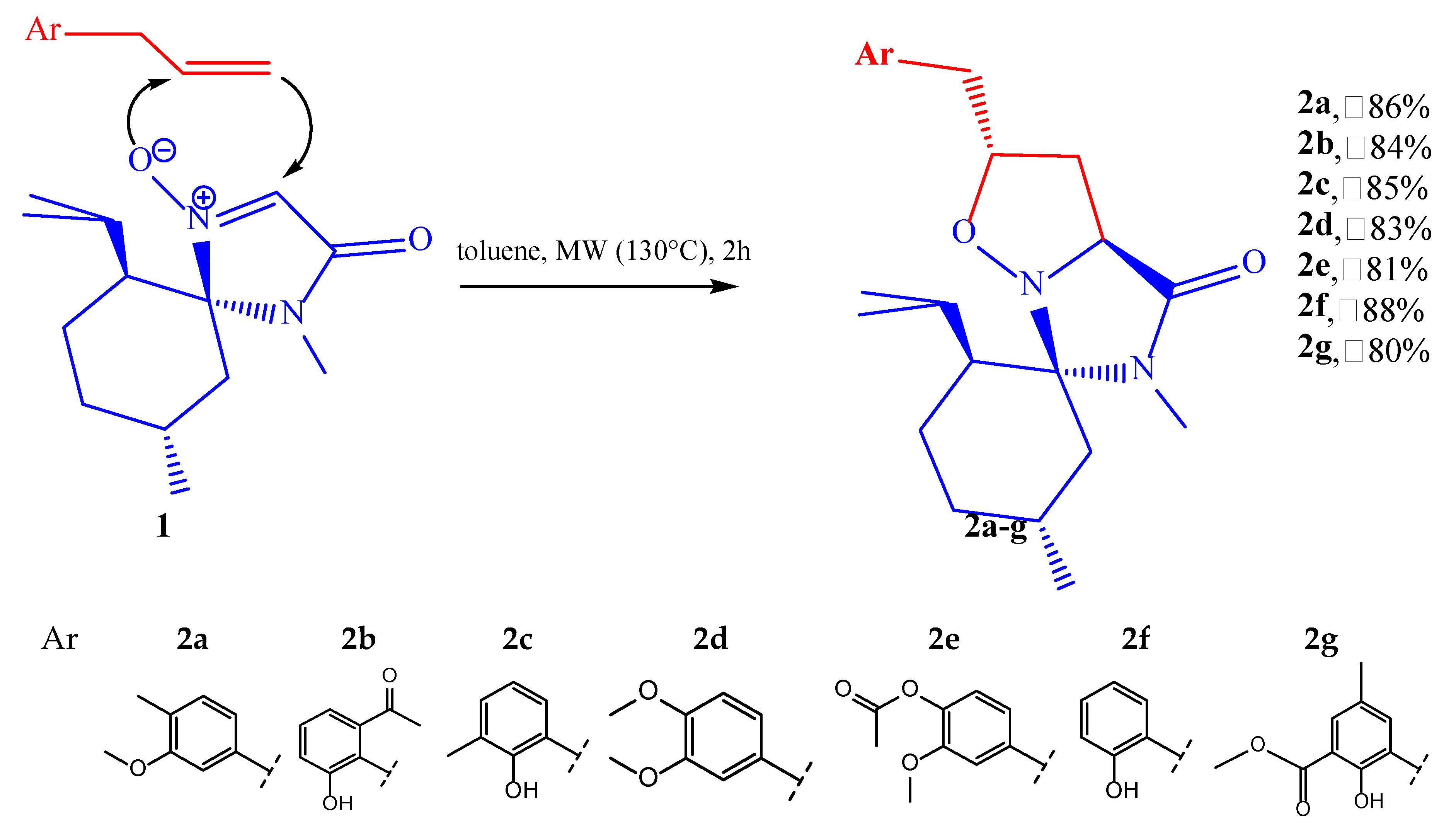
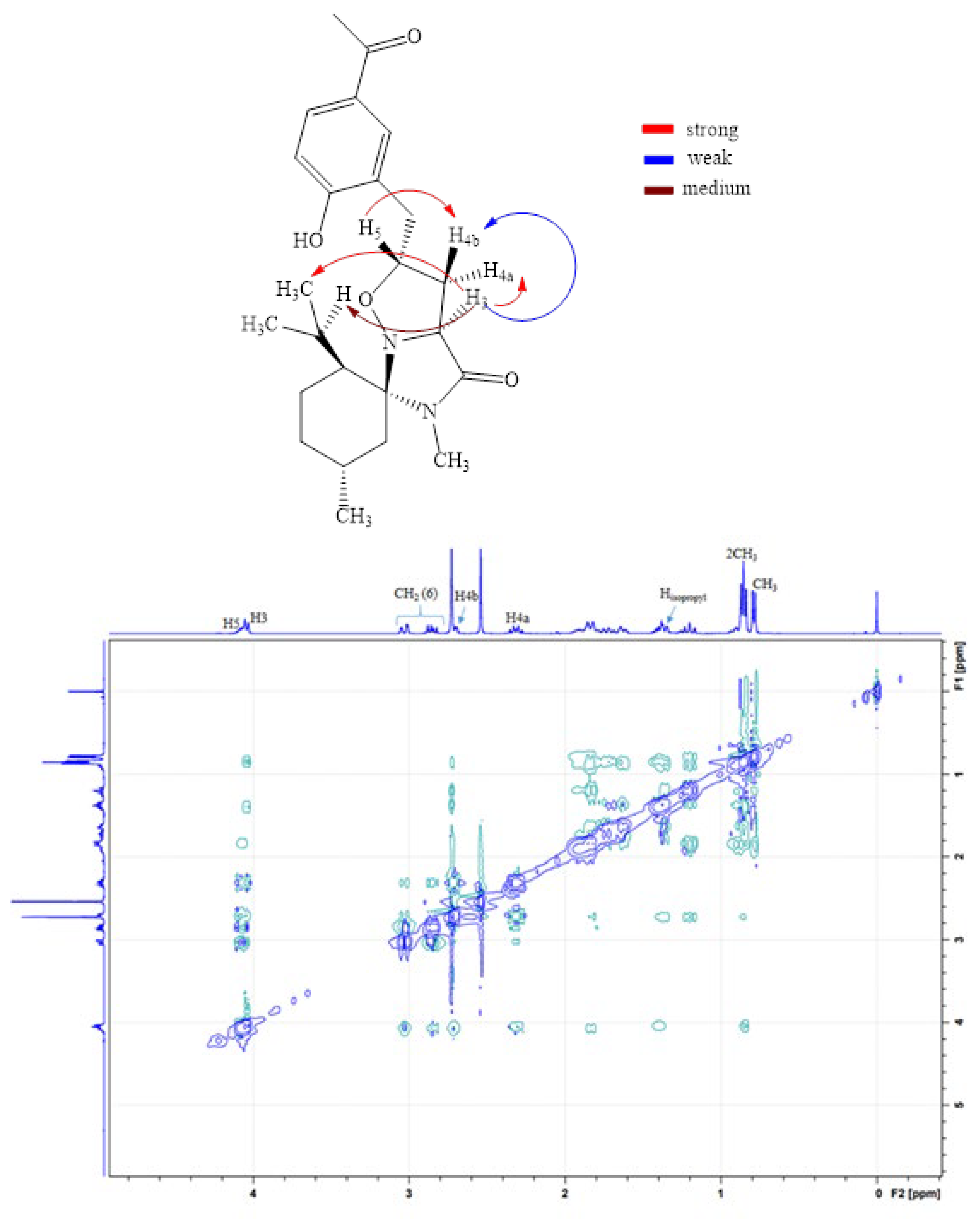
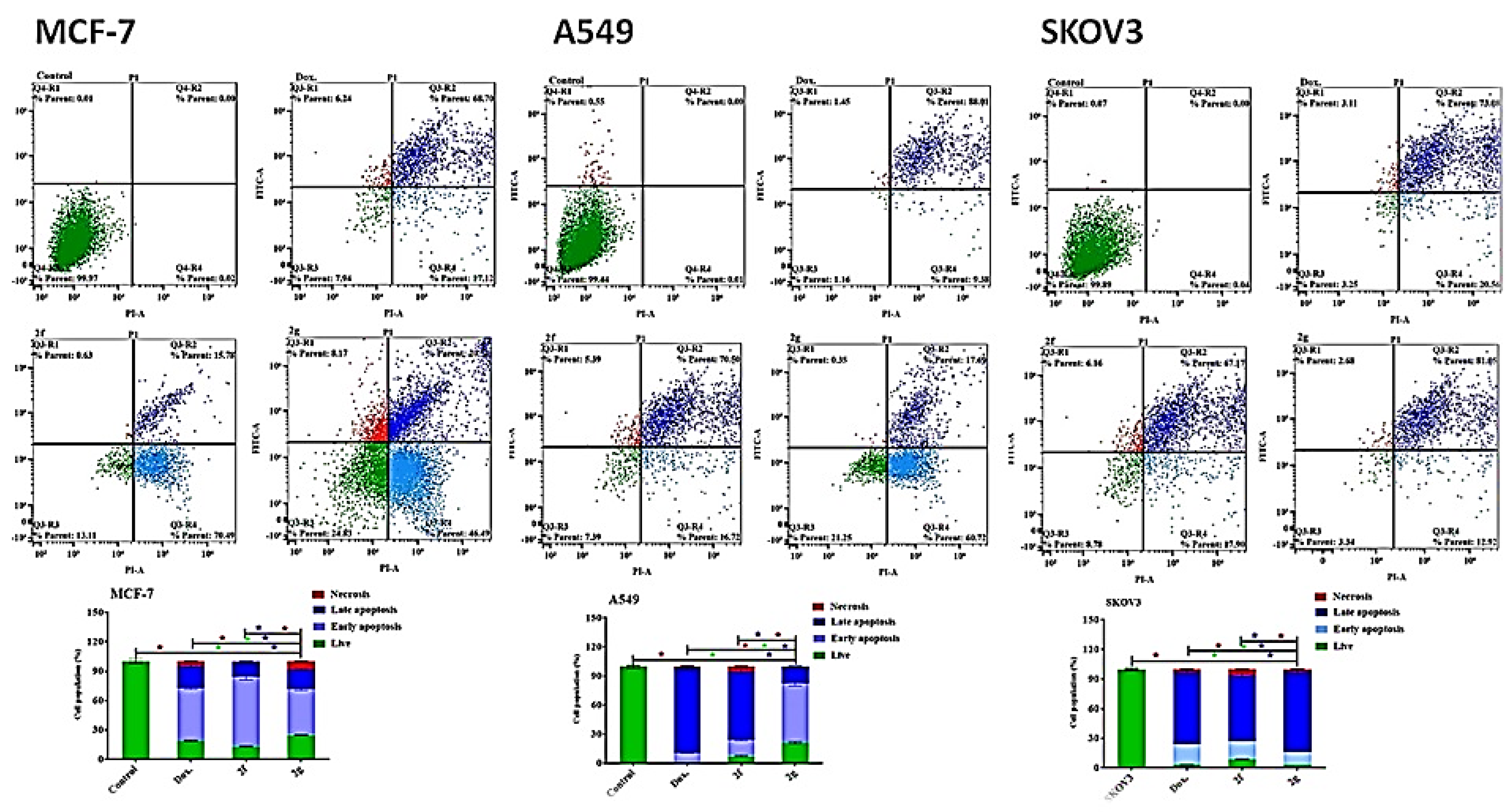
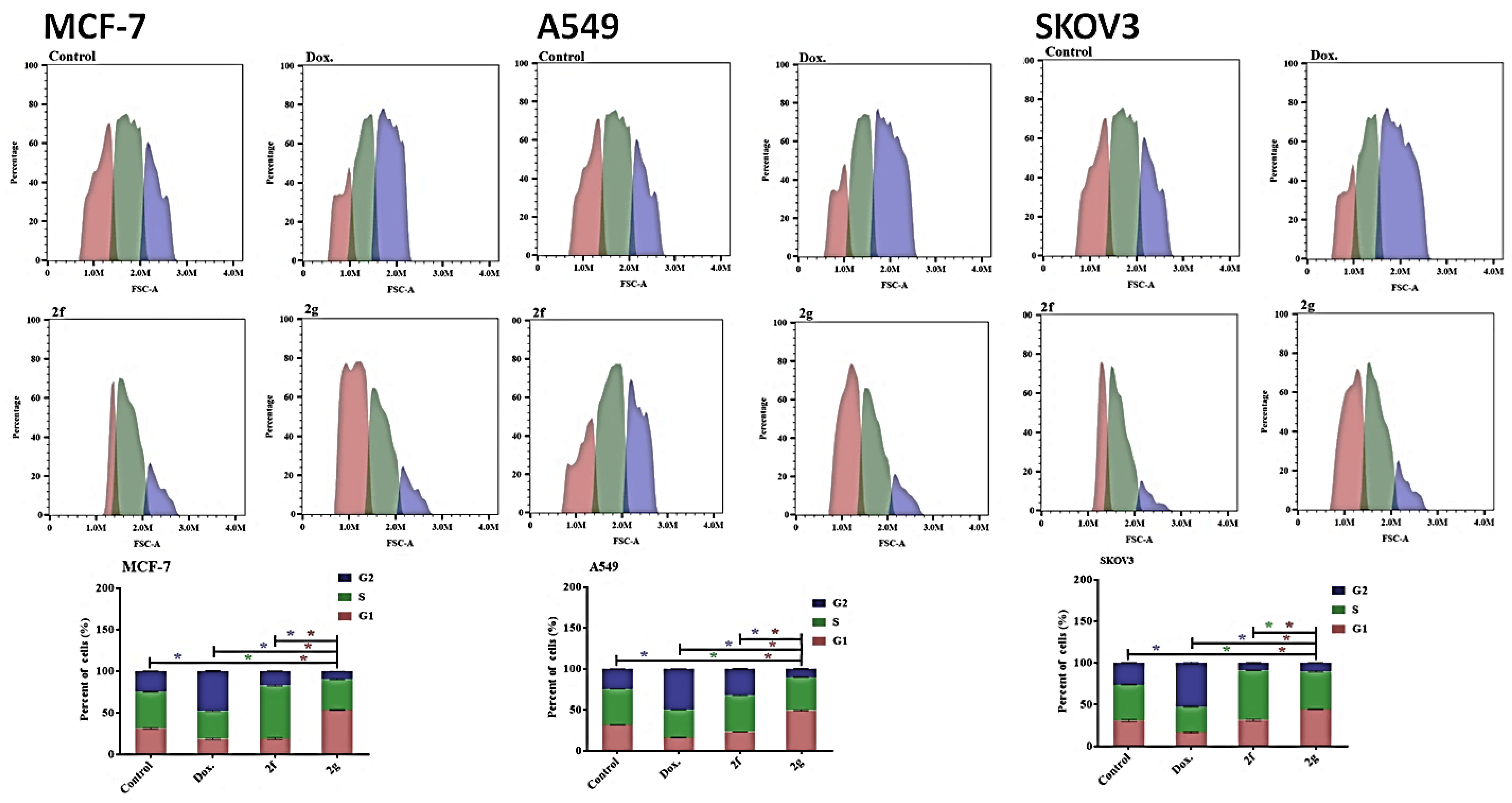
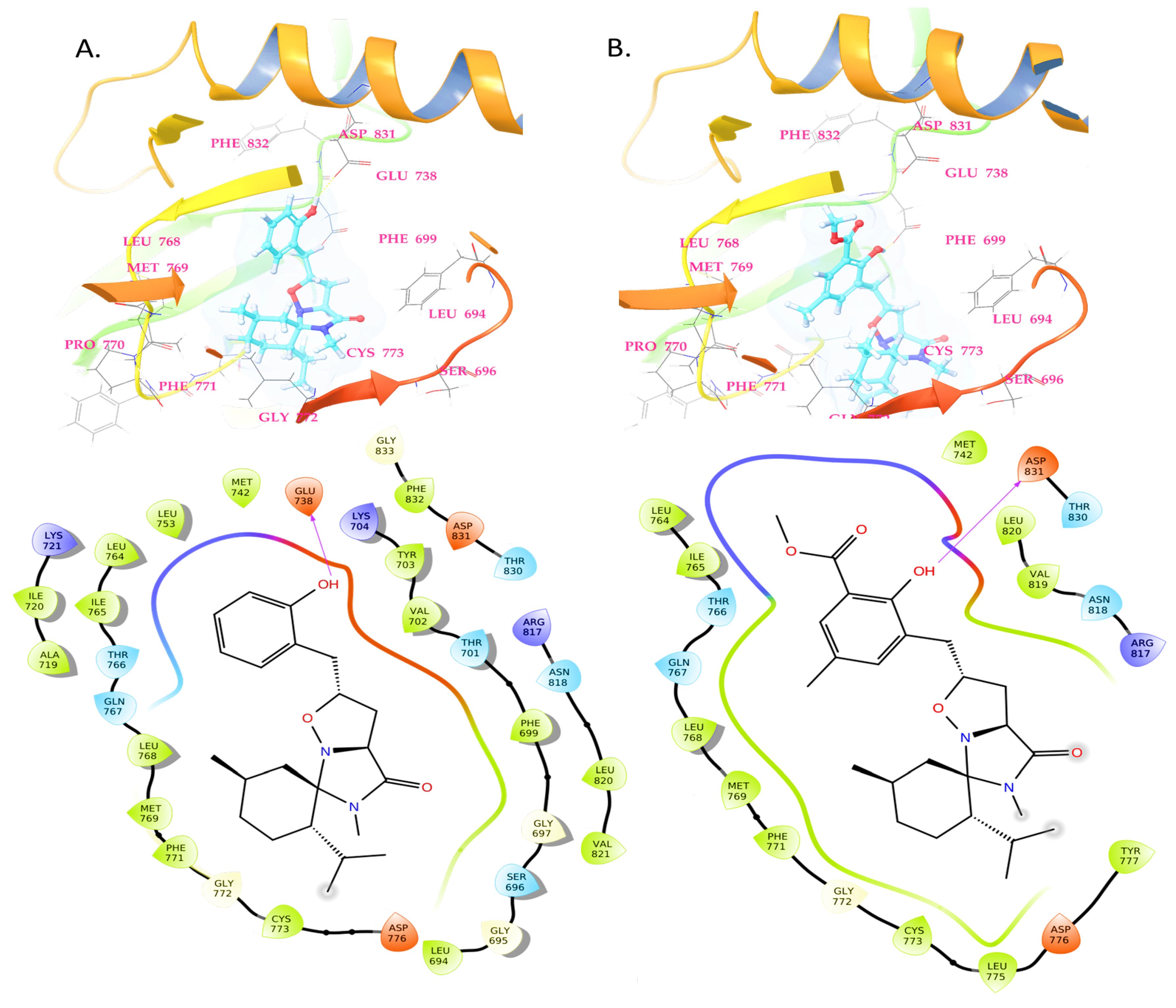
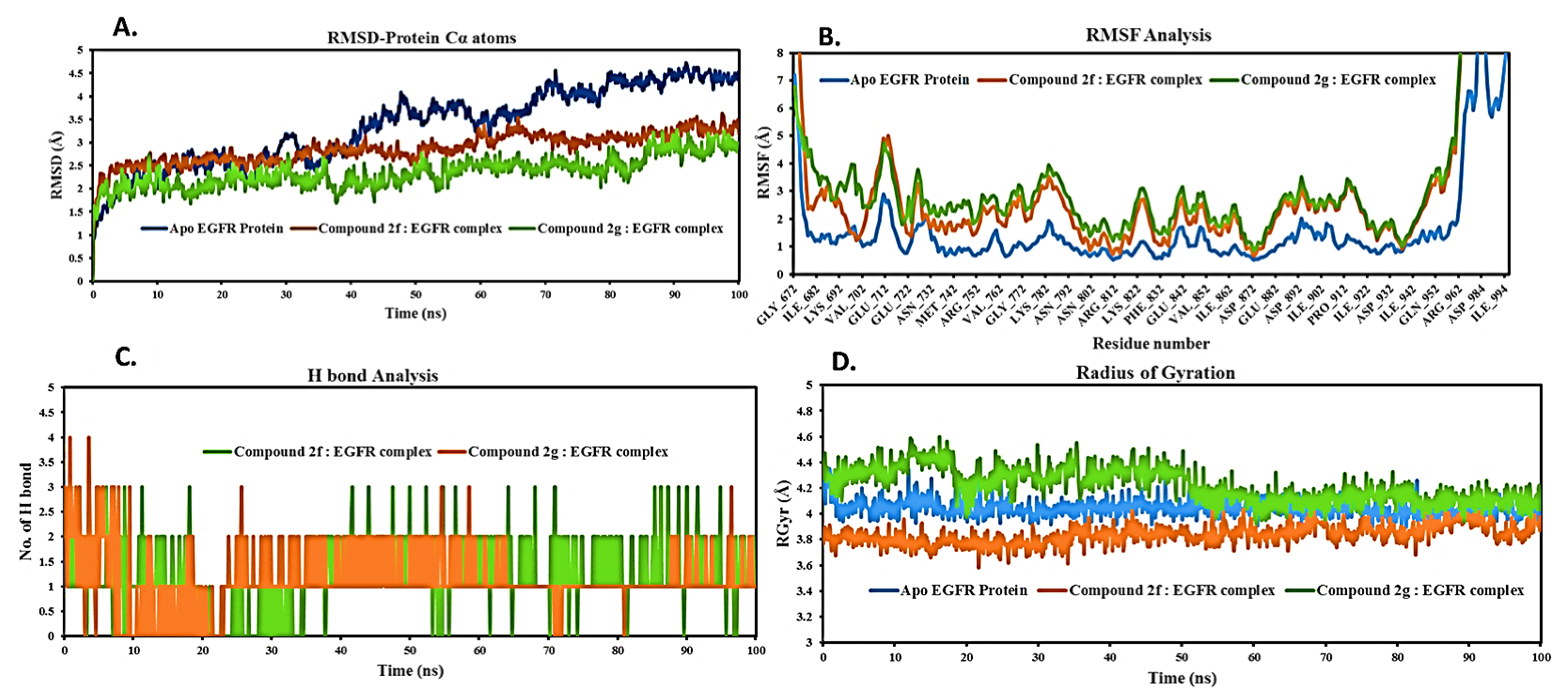
| Entry | IC50 (µM) | |||
|---|---|---|---|---|
| MCF-7 | A549 | SKOV-3 | EGFR | |
| 2a | 21.3 ± 0.5 | 18.1 ± 0.7 | 14.5 ± 0.9 | - |
| 2b | 22.2 ± 0.3 | 48.7 ± 0.9 | 18.3 ± 0.9 | - |
| 2c | 7.2 ± 0.2 | 35.4 ± 0.14 | 19.4 ± 1.4 | - |
| 2d | 8.7 ± 0.5 | 25 ± 2.5 | 27.6 ± 2.2 | - |
| 2e | 66.8 ± 2.7 | 53.5 ± 1.1 | 27.9 ± 1.9 | - |
| 2f | 17.7 ± 1 | 12.1 ± 1.1 | 13.9 ± 0.7 | 0.298 ± 0.007 |
| 2g | 9.7 ± 1.3 | 9.7 ± 0.7 | 6.5 ± 0.9 | 0.484 ± 0.01 |
| Doxorubicin | 2.8 ± 0.4 | 4.2 ± 0.24 | 4.2 ± 0.013 | - |
| Afatinib | - | - | - | 0.074 ± 0.001 |
| Positive Control (%) | 2f (%) | 2g (%) | |
|---|---|---|---|
| MCF-7 | |||
| Intact cells | 7.94 | 13.11 | 24.83 |
| Early apoptosis | 17.12 | 70.48 | 46.49 |
| Late apoptosis | 68.7 | 15.78 | 20.51 |
| Necrosis | 6.24 | 0.63 | 8.17 |
| Total death | 92.06 | 86.89 | 75.17 |
| A459 | |||
| Intact cells | 1.16 | 7.39 | 21.24 |
| Early apoptosis | 9.38 | 16.72 | 60.72 |
| Late apoptosis | 88.01 | 70.5 | 17.69 |
| Necrosis | 1.45 | 5.39 | 0.35 |
| Total death | 98.84 | 92.61 | 78.76 |
| SKOV3 | |||
| Intact cells | 3.25 | 8.78 | 3.34 |
| Early apoptosis | 20.56 | 17.9 | 12.92 |
| Late apoptosis | 73.08 | 67.16 | 81.05 |
| Necrosis | 3.11 | 6.16 | 2.68 |
| Total death | 96.75 | 91.22 | 96.65 |
| G0/G1 | S | G1/G2 | |
|---|---|---|---|
| MCF-7 | |||
| 2f | 19 ± 1.2 | 63.3 ± 0.6 | 17.7 ± 0.8 |
| 2g | 53.7 ± 0.6 | 36.3 ± 0.6 | 10 ± 0.1 |
| Control | 31.3 ± 1.4 | 43.7 ± 1.5 | 24.9 ± 0.7 |
| Doxorubicin | 18.4 ± 0.9 | 34 ± 0.6 | 47.6 ± 0.9 |
| A549 | |||
| 2f | 23.1 ± 0.8 | 44.4 ± 0.5 | 32.5 ± 0.4 |
| 2g | 49.3 ± 0.7 | 40.2 ± 0.3 | 10.4 ± 0.5 |
| Control | 31.9 ± 0.2 | 43.4 ± 0.04 | 24.7 ± 0.3 |
| Doxorubicin | 16.12 ± 0.54 | 34.01 ± 0.24 | 49.9 ± 0.343 |
| SKOV3 | |||
| 2f | 31.4 ± 1.2 | 59.5 ± 0.2 | 9.2 ± 1.3 |
| 2g | 44.5 ± 0.6 | 44.8 ± 1.6 | 10.7 ± 0.7 |
| Control | 30.8 ± 1.5 | 43.1 ± 0.6 | 26.1 ± 1 |
| Doxorubicin | 16.7 ± 1 | 30.7 ± 0.6 | 52.5 ± 1.5 |
| Entry | 2f | 2g | 2f | 2g |
|---|---|---|---|---|
| Physicochemical/Druglikeness | ||||
| Molecular weight | 372.50 g/mol | 444.56 g/mol | 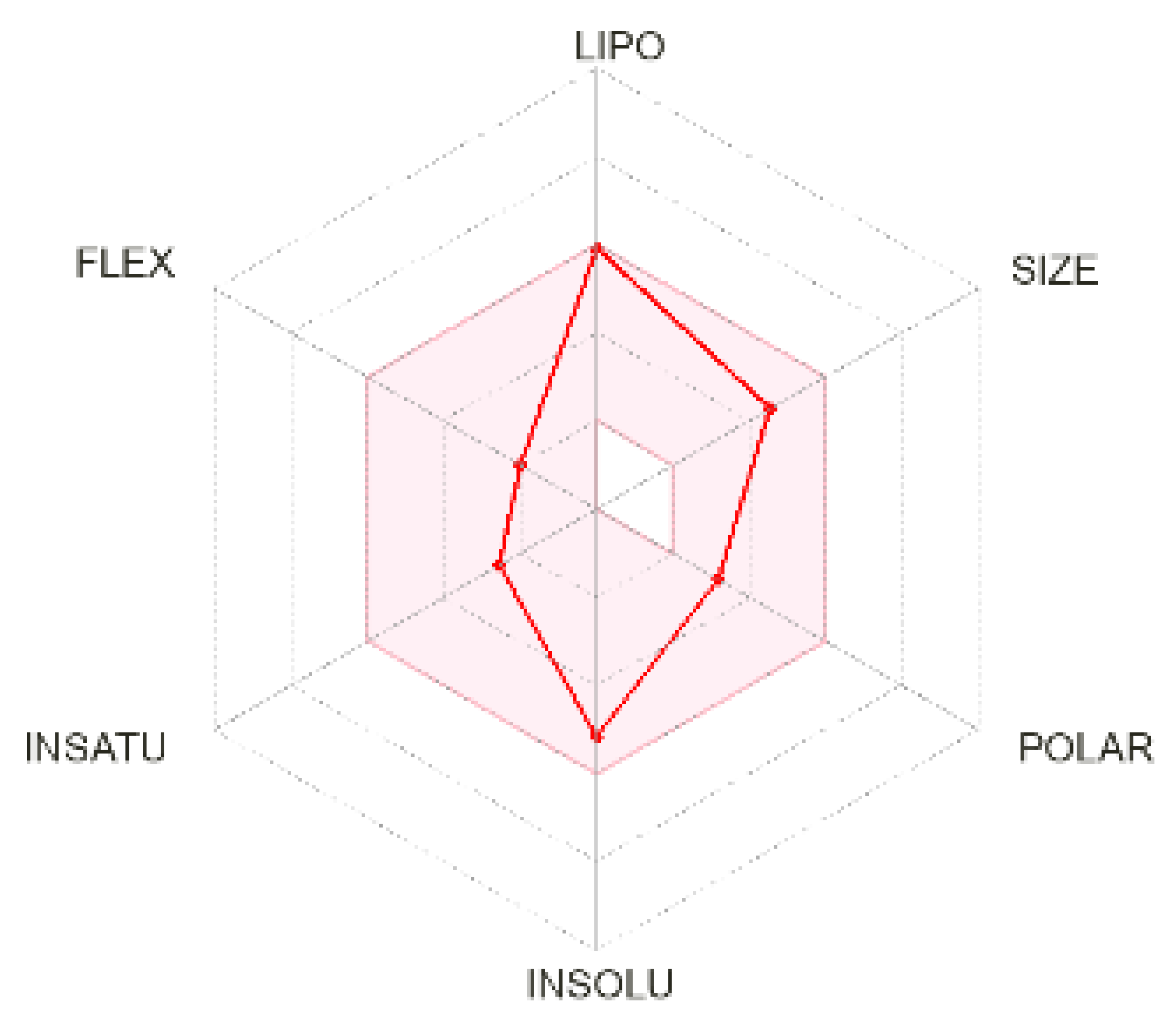 | 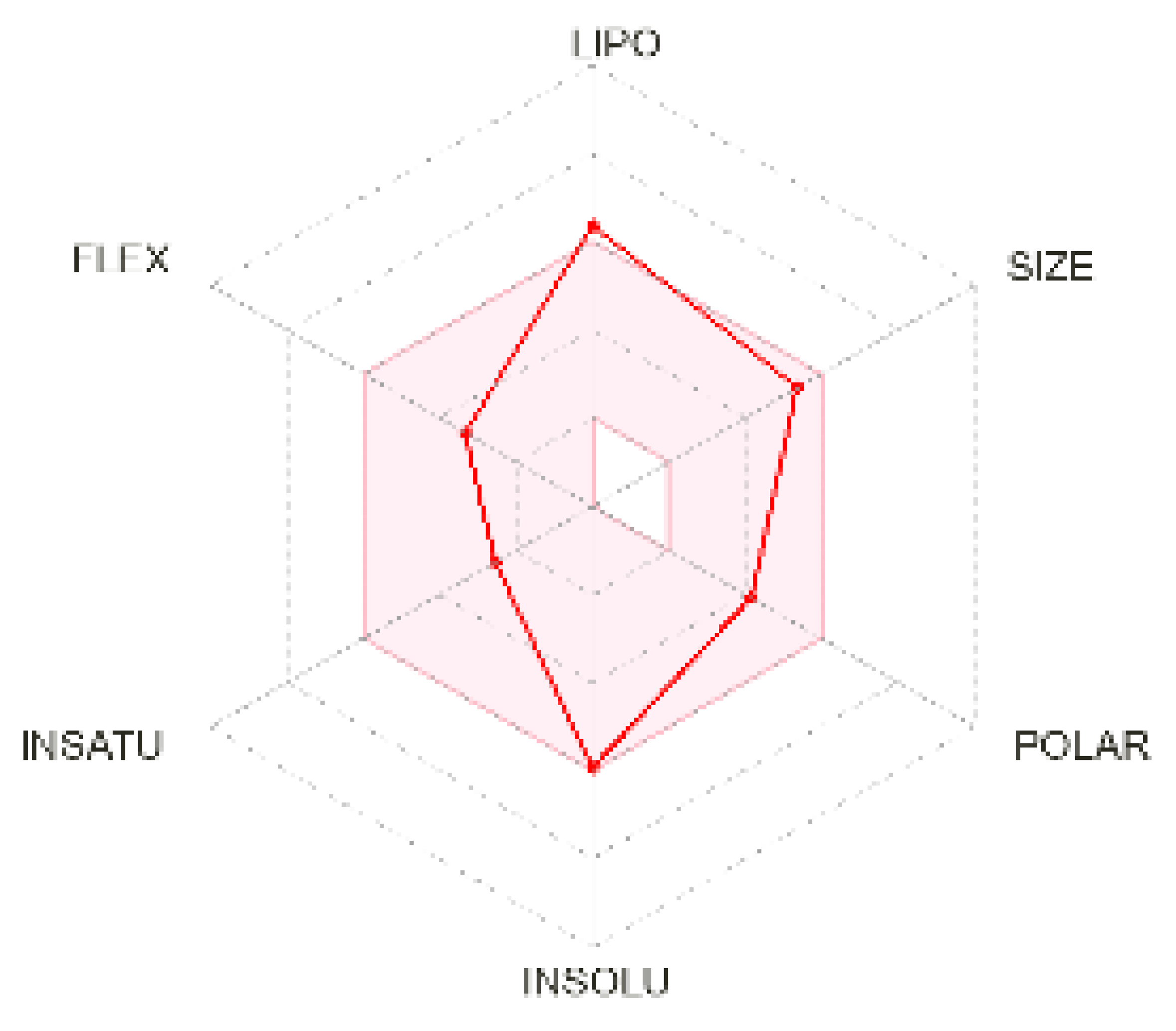 |
| Num. heavy atoms | 27 | 32 | ||
| Num. arom. heavy atoms | 6 | 6 | ||
| Num. rotatable bonds | 0.68 | 0.68 | ||
| Num. H-bond acceptors | 3 | 5 | ||
| Num. H-bond donors | 4 | 6 | ||
| Molar Refractivity | 1 | 1 | ||
| TPSA | 114.14 | 130.38 | ||
| Consensus Log Po/w Lipinski’s Rule | 3.31 Yes | 3.79 Yes | ||
| Bioavailability Score | 0.55 | 0.55 | ||
| Pharmacokinetics | BOILED-Egg model | |||
| GI absorption | High | High |  | |
| BBB permeant | Yes | No | ||
| P-gp substrate | No | No | ||
| CYP1A2 inhibitor | No | No | ||
| CYP2C19 inhibitor | No | Yes | ||
| CYP2C9 inhibitor | No | No | ||
| CYP2D6 inhibitor | Yes | Yes | ||
| CYP3A4 inhibitor | No | Yes | ||
| Log Kp (cm/s) | −5.14 | −5.03 | ||
Disclaimer/Publisher’s Note: The statements, opinions and data contained in all publications are solely those of the individual author(s) and contributor(s) and not of MDPI and/or the editor(s). MDPI and/or the editor(s) disclaim responsibility for any injury to people or property resulting from any ideas, methods, instructions or products referred to in the content. |
© 2023 by the authors. Licensee MDPI, Basel, Switzerland. This article is an open access article distributed under the terms and conditions of the Creative Commons Attribution (CC BY) license (https://creativecommons.org/licenses/by/4.0/).
Share and Cite
Alminderej, F.; Ghannay, S.; Elsamani, M.O.; Alhawday, F.; Albadri, A.E.A.E.; Elbehairi, S.E.I.; Alfaifi, M.Y.; Kadri, A.; Aouadi, K. In Vitro and In Silico Evaluation of Antiproliferative Activity of New Isoxazolidine Derivatives Targeting EGFR: Design, Synthesis, Cell Cycle Analysis, and Apoptotic Inducers. Pharmaceuticals 2023, 16, 1025. https://doi.org/10.3390/ph16071025
Alminderej F, Ghannay S, Elsamani MO, Alhawday F, Albadri AEAE, Elbehairi SEI, Alfaifi MY, Kadri A, Aouadi K. In Vitro and In Silico Evaluation of Antiproliferative Activity of New Isoxazolidine Derivatives Targeting EGFR: Design, Synthesis, Cell Cycle Analysis, and Apoptotic Inducers. Pharmaceuticals. 2023; 16(7):1025. https://doi.org/10.3390/ph16071025
Chicago/Turabian StyleAlminderej, Fahad, Siwar Ghannay, Mohamed O. Elsamani, Fahad Alhawday, Abuzar E. A. E. Albadri, Serag Eldin I. Elbehairi, Mohammad Y. Alfaifi, Adel Kadri, and Kaïss Aouadi. 2023. "In Vitro and In Silico Evaluation of Antiproliferative Activity of New Isoxazolidine Derivatives Targeting EGFR: Design, Synthesis, Cell Cycle Analysis, and Apoptotic Inducers" Pharmaceuticals 16, no. 7: 1025. https://doi.org/10.3390/ph16071025
APA StyleAlminderej, F., Ghannay, S., Elsamani, M. O., Alhawday, F., Albadri, A. E. A. E., Elbehairi, S. E. I., Alfaifi, M. Y., Kadri, A., & Aouadi, K. (2023). In Vitro and In Silico Evaluation of Antiproliferative Activity of New Isoxazolidine Derivatives Targeting EGFR: Design, Synthesis, Cell Cycle Analysis, and Apoptotic Inducers. Pharmaceuticals, 16(7), 1025. https://doi.org/10.3390/ph16071025








